Portugal 2019: Friends, Food and Sights
A friend from graduate school ages ago sent me a message on Facebook, where I had posted photos of Porto, asking if I would be there in two days when he planned to arrive. By then, I was in Lisbon and let him know that. It turned out that he too was in Lisbon. I was traveling in Portugal with a friend from undergraduate days, and another joined us for a weekend, and all of us visited a third who lives in Monte Estoril, not far from Lisbon. Tourism took a backseat to friendship and lively conversations over good food and wine, but we did manage to also absorb the history and delightful ambiance of Portugal.
Porto
Rua das Flores, where our town-house hotel in Porto was located, is a busy pedestrian-only street lined with shops and restaurants, walking distance to the Douro River and many of the city’s main sights. We walked a lot, especially along the river, and also took the tourist double-decker bus tours to get a scan of the city. The cable car ride up to the Convent on the hill in Gaia on the other side of the Douro River, and the short walk over the top level of the Dom Luis Bridge back to Porto, turned out to provide a better perspective.

The old town of Porto is walkable, but modern Porto is a fairly large city with almost 2 million inhabitants. References to it go back to Roman times, but recognition as a city came in the early 5th Century. Its name eventually morphed into Portugal. Situated at the confluence of the Douro River with the Atlantic Ocean, it was known for commerce through Roman and Moorish rule and, in the 14th and 15th centuries for shipbuilding, when it contributed to the Portuguese fleet. Later its importance shifted to the export of wine from the Douro Valley. In the early 18th Century, because of an advantageous trade treaty with England, exports of wine to the island increased and gradually production passed to English firms, which located their warehouses in Gaia because of lower taxes.
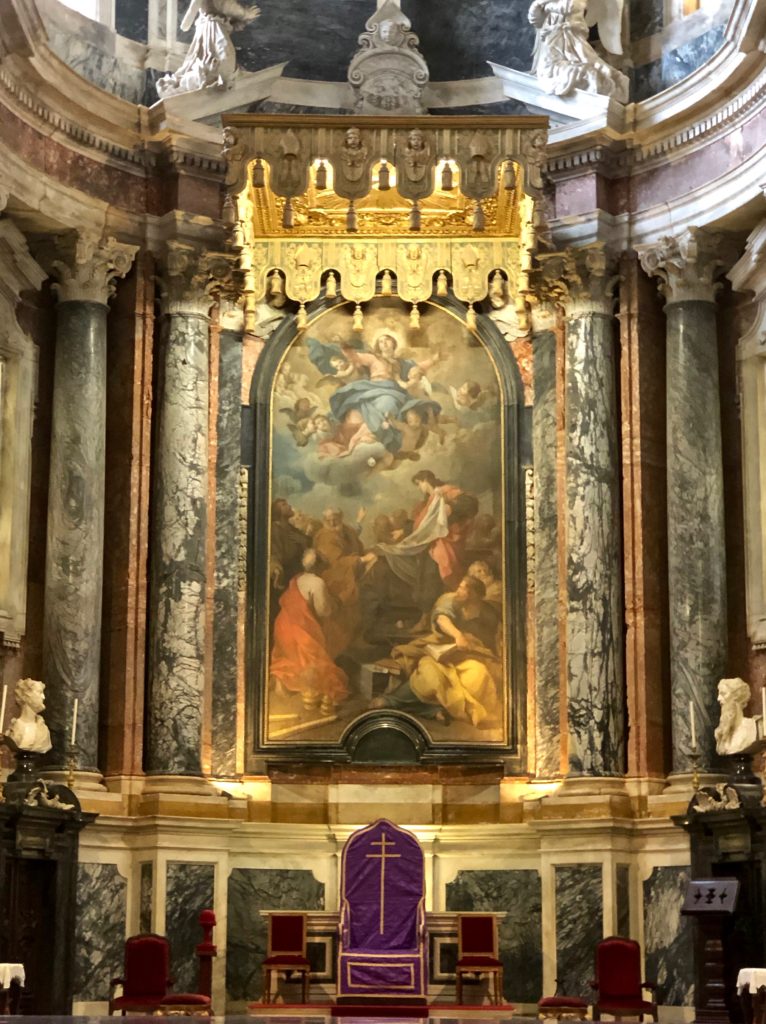
Among the historic sights, Clerigos Church (Baroque) has a remarkably ornate alter, Sao Francisco (Baroque) and Porto Cathedral (Romanesque) were impressive and Sao Bento Train Station is an imposing structure with tile murals inside. Porto University and the churches with blue tile murals nearby were interesting to walk by and the Art Museum had some interesting pieces. We were not able to visit Porto’s Stock Exchange Palace, an important historical site, because of an event there. The six-bridges cruise along the Douro gave a feel for the old walled city and for commerce along the river to the ocean. Of course we tasted Port wine in a tasting room and later my friend tried one of Sandeman’s at their outdoor tables facing the river. I walked up the steep hill to Taylor’s to taste their white chip dry port, like a sherry, which I thought would make a good aperitif. Without the construction crane in the way, the view from their restaurant would have been spectacular.
The highlights in Porto were the visit to the Serralves Museum, Lello bookshop and dinner at Pedro Limao. Serralves is a museum for modern art built in the grounds of an aristocrat’s villa. The new structure, with ample exhibition space, showed avant garde works of a few artists that I did not know of and was not able to appreciate, but the old villa set in lovely manicured gardens, strewn with unusual sculptures, had a spectacular exhibit of about 35 works of Joan Miro. It was titled “The Death of Painting” and had slashed, punctured and burnt canvases and woven reliefs. Joan Miro, and a collaborator for the woven pieces, expressed their rage at critics that had announced the death of painting.

The magnificent, colorful, winding staircase leading upstairs to shelves lined with books under a colorful stained glass ceiling is at the center of Librarie Lello. This sight apparently inspired J.K. Rowling’s Harry Potter series, which in return is a source of revenue for the bookstore as it charges visitors Euro 6 for a visit and Euro 12.5 to jump the waiting line.
Suggested in an article in the Guardian Newspaper, we found our way to Pedro Limao, a small restaurant with just six tables, to try its tasting menu of ten courses paired with five wines. If you think that was too much food and wine, you would be wrong about the food and right about the wine. The food was light and portions were small. Although the menu was terse in describing the courses, the waiter was voluble, especially as only two tables were occupied that evening. My memory is hazy, but online I found the amuse bouche described as a shrimp ceviche with peels and coriander shingle; and another dish as tuna tartare marinated in miso and smoked with almond milk and a green sauce foam. A later course was called “give me a break”, but I cannot remember its content. For the haze, I have the wine to blame, glasses of 2 whites, 2 reds and a port, all really good, but with unfamiliar local names and varieties. I did ask the waiter to request Chef Limao, who was not present, to send me an email with more detail, but he did not.
Lisbon
At the ticket office in Porto’s railway station, the clerk asked for my age. When I replied, he offered me a 50% discount. It turned out that generous senior discounts are offered for transport, at museums and other venues throughout Portugal. The comfortable train ride to Lisbon took just short of three hours, sometimes hugging the coast, but mostly inland.
Lisbon is a big international city with about 3 million people in the metropolitan area, but the main tourist sights, except for Belem, are in a compact space, although not quite as walkable as Porto. Because its located at the confluence of the Tagus River and Atlantic Ocean, it has been inhabited since ancient times and has a rich history. Its name suggests that it provided a “safe harbor”, which may have been derived from the Phoenician Alis-Obu or Celtic Olisippo/Lissoppo. It was later integrated into the Roman Empire as a municipality. Muslims ruled the Lisbon area for about four centuries from 711 CE before it was taken over by Christians. Its golden age was from the late 15th Century to the early 17th Century, when explorers like Vasco de Gama set sail from here to Africa and Asia during the age of discovery.
We arrived at Santa Apolonia railway station situated by the river below the castle up on a hill and about a mile from our hotel, which was by the waterfront, closer to the ocean. The hotel was also at the bottom of Bairro Alto and next to Chiado and Baixa, and not far from Alfama, covering most of tourist Lisbon. After a late lunch, as it was a sunny and warm day, we walked along the river, past cafes and street art, people sitting and listening to music and, where it was possible, dipping their feet in the water, relaxing after a few preceding days of bad weather. A friend who lives in Bergamo (Italy) arrived in the evening to join us for the weekend.
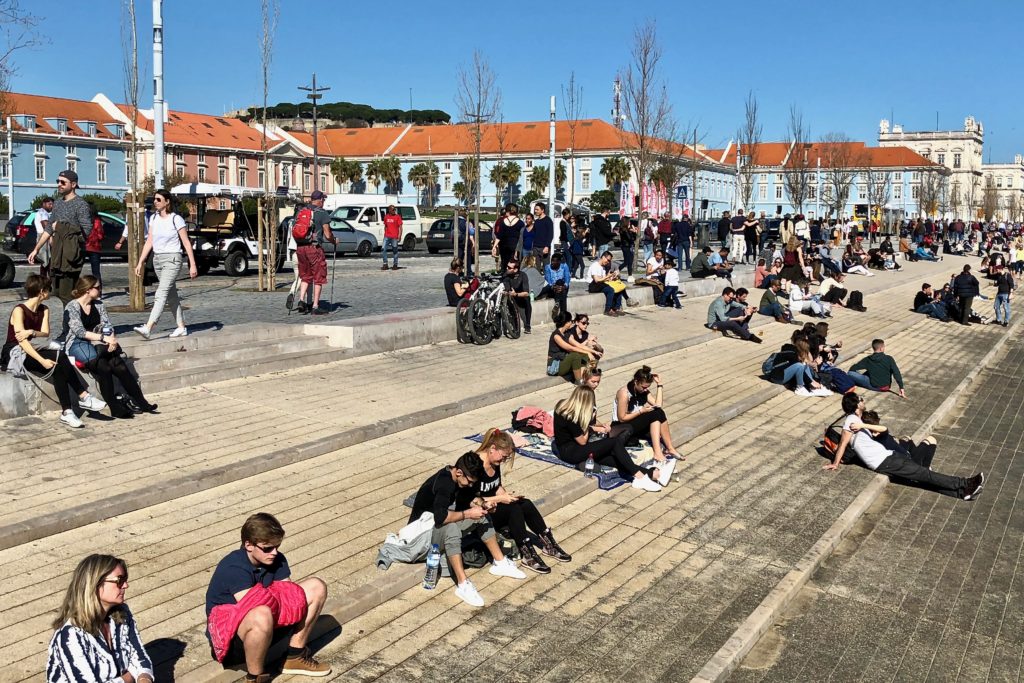
The next morning, we rode on a double-decker tour bus around Lisbon. As the big bus could only travel on few of the larger roads in the old part of town, most of the tour was of modern Lisbon, a large sprawling city with impressive parks and great views. We discovered the “Time Out” market near our hotel, a huge rectangular hall lined with food stalls offering a variety of cuisines with long tables in the center to sit and eat. The giant grilled tiger prawn, like a lobster, and varieties of bachalau (cod), became favorites, especially when accompanied with Alvarinho, a light green (young) wine.
In the afternoon, I found my way with difficulty through the maze of streets to St. George’s Castle to join my graduate school friend on a walking tour of Alfama. During the two-hour walk down winding narrow stone-paved lanes I tried to combine listening to the guide’s commentary about the neighborhood with catching up with my friend’s life since we last met a couple of decades ago, but failed to absorb much of either. I gathered that the medieval looking Alfama dates back to before the Moorish period, and later became home to mariners and fishermen. Because it’s on a hill, it survived the devastating earthquake and tsunami of 1755 that destroyed most of Lisbon.

Alfama’s lanes were lined with small houses that had tiny wrought iron balconies and a strip of colorful tiles around the neck of the house, just under the roof. At one point, a window opened and the guide explained that we could get a sip of local liquor for E1, which many of us did. Where lanes met and there was an opening, a café with tables outside, or a small park would fill it, and some visible sides of houses could have large murals on them. One opening had a small park with a giant mural of Amelia Rodrigues, the legendary Fado singer, and further down the tour ended near the Fado museum. My friend and I found a café nearby and had a long catch-up chat lubricated by a carafe of green wine.

The four of us had an outstanding dinner at Prado, a restaurant that offers modern cuisine. Unusual dishes like minhota beef tartare, shiitake and grilled cabbage; hispi cabbage, whey and sunflower seeds; wild Portuguese seas bass, cauliflower and chestnut mushrooms; and the extraordinary mushroom ice cream, pearl barley, dulse & caramel. The white and red wines suggested by staff brought out the complex flavors. As if the dinner was not sufficient, we went to O Faia, well-known for its Fado music, where we listened to a few sets of songs accompanied by an obligatory bottle of Port. Although Fado means fate, the singing style is soulful, “saudade”, the sound of the Portuguese word conveys its meaning well. The lyrics express sadness for the adventurers’ and mariners’ departure and hopes for the reunion when they return. I was reminded of an “Eastern” style of emotional expression when the singer brought one hand to her ear and the other outstretched, appealing for sympathy or appreciation.
The next day, another sunny morning, the four of us piled into an Uber to drive about 30 kilometers to Cascais, a resort village on the coast. It has maintained its old town well, clean streets lined on both sides with cute shops and cafés, like resort towns the world over. Passing through the center, we walked along the boardwalk, hugging the ocean, some deep or long beaches, or rocks jutting out of the water where the waves would shower them, to Monte Estoril where our local friend lives. We sat in his apartment’s balcony with a view of the ocean and solved the world’s problems before heading back to Cascais to lunch at an indoor market similar to Time Out. We were joined there by another friend-author whose books I have enjoyed reading, and continued our broad-ranging discussion. Back in Lisbon by early evening, our week-end visitor departed for the airport.
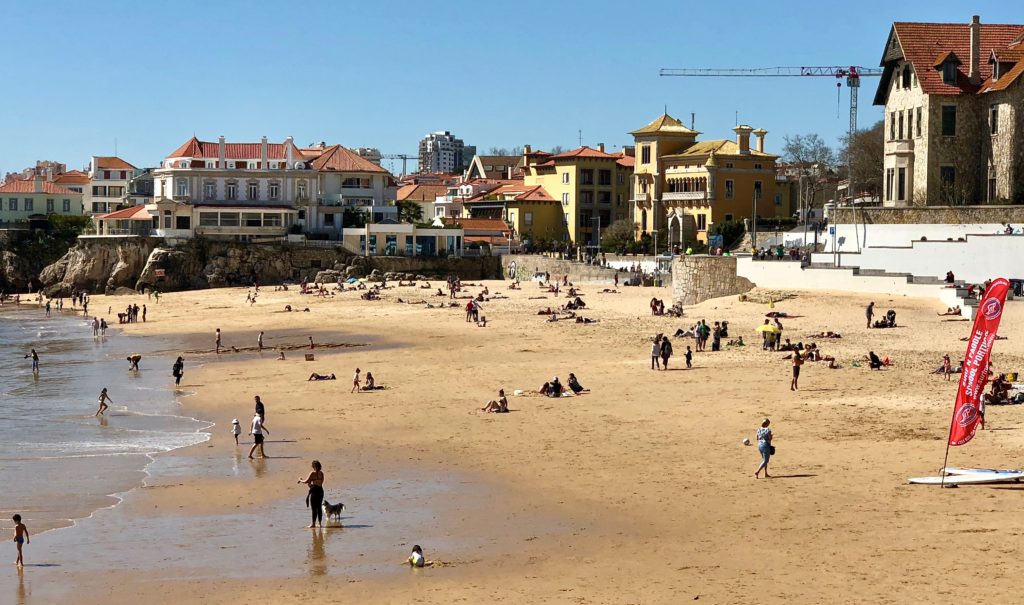
On our final day together in Lisbon, the remaining three of us took an antique tram to Belem to see the huge, impressive Monastery Jeronimos, built in the early 16th Century with “pepper money”, the tax on spices brought back from India. Unfortunately, it was closed on Monday, a schedule we did not check. My friends took the loss as I had walked through the church and cloisters on a previous visit. As a consolation, we went to the Casa Pasteis de Belem to taste their famous pastel de Nata, a custard tart. It turned out not to be as good as the one offered free in our hotel every afternoon. Feeling disappointed, two of took the tram back to our hotel to pick up our luggage and a car and set off for the Algarve.
At the end of the trip to the Algarve and Alentejo regions, my friend left when we got back to Lisbon, but I stayed for an extra day to visit again my friends in Monte Estoril and Cascais. On the first evening, alone in Lisbon, I walked to a modern wine bar-restaurant, “By the Wine”, near the hotel to taste some local wine with a light dinner. The person on the next stool at the bar, who was an organic farmer, told me that Antonio Costa, the Prime Minister of Portugal was of Indian origin. I googled him and sure enough his grandfather had migrated from Goa and his father had spent time there as well. In return, I informed him that the Prime Minister of Ireland, Leo Varadkar was also of Indian origin and his father and I share the name Ashok. With these two, and the Mayor of London, Sadiq Khan, South Asian migrants to Europe are making their presence felt.
Early the next day, I followed up on a commission by a friend in Marin to find a painting of Fernando Pessoa, one of Portugal’s greatest authors. Hotel staff directed me to a bronze statue in the likeness of the painting outside a café not far from the hotel. The statue was indeed of Pessoa sitting on a chair with a table in front with another empty chair beside his. I walked up and sat on the empty chair and took a selfie to send to my friend. The painting was apparently in his former house, now a cultural center, which was closed for renovation.

I spent the rest of the morning in scenic Monte Estoril with my friend and his daughter, and had a late afternoon lunch in lovely Cascais with my author-friend. I came back to Lisbon to dine with a local person introduced to me by another friend from Marin, at a traditional Portuguese seafood restaurant, Cervejaria de Trinidade, which was first a monk’s refectory, then a beer hall, and still looked like a church with painted tiles on the walls up to a high ceiling. The clams, shrimp and prawns were as fresh as could be, but the preparation was simple, letting the seafood speak for itself, and the Alvarinho wine continued to delight.
Algarve
Many Central and North Europeans visit or migrate to the Algarve region in the south of Portugal because of its warmer climate, summer sun and beaches, and fresh seafood and fruit. It also has a rich cultural history going back to Phoenicians, Celts, Romans, Visigoths, Moors and finally the Kingdom of Portugal when the name was changed from Al-Gharb. We drove down on highway A2 from Lisbon, usually lightly trafficked because of expensive tolls, but about an hour out we were stopped by a police car and diverted because of an accident to a winding country road with 2-way traffic. After an hour or so we found out at a petrol station that the highway had re-opened. The drive took about 5 hours instead of 3. Still, we got to see a lot more of the lush countryside and were surprised by how sparsely populated Portugal is.
We arrived at our modern hotel in Lagos soon after it turned dark, too hungry and tired of sitting in a car to notice that the promenade in front of the hotel was lined with palm trees with a stream behind them. We hurried to the old town nearby to be on time for our reservation at Restaurante Dom Sebastiao, recommended in Rick Steves guidebook. It was disappointingly touristy and the food was mediocre, soggy fish and mushy vegetables, all overcooked. The next morning, walking around we discovered how lovely the old town was, like Cascais, with narrow stone lanes that opened to squares with stone patterns on the ground and fountains in the center, surrounded by houses with small wrought iron balconies and a layer of patterned tiles below the roof as in Alfama.
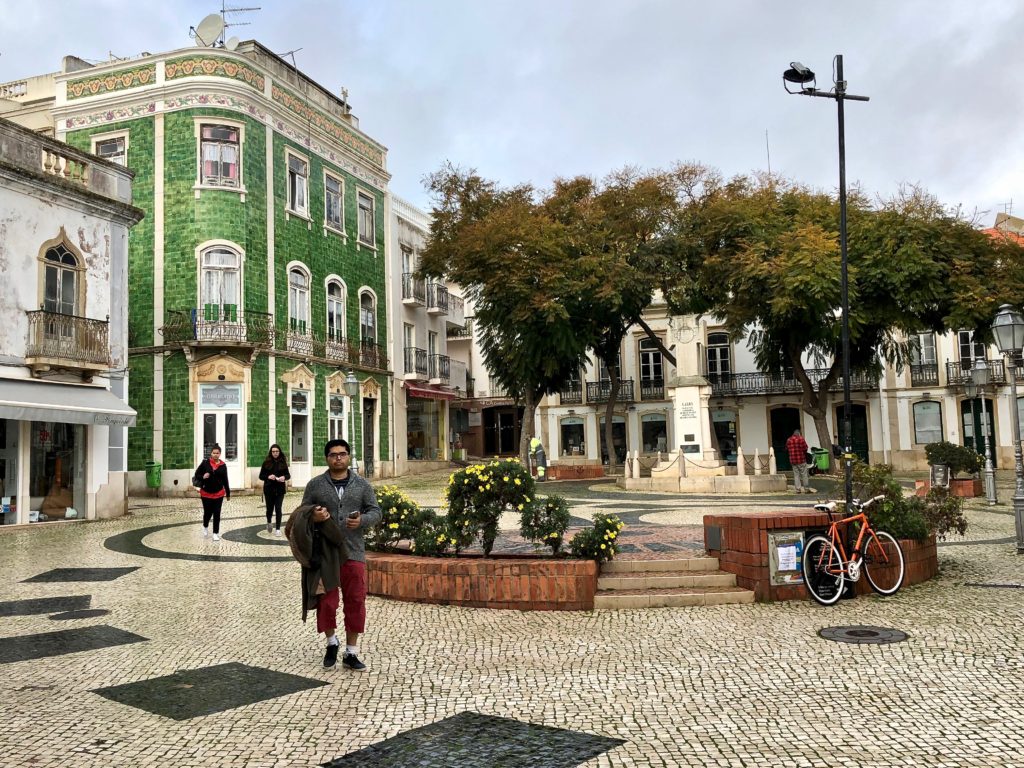
Lagos was the main port for trade in the Algarve for centuries, important during the age of discovery and, unfortunately, also the center of the slave trade. It remained the capital of the region until the 1755 earthquake and Tsunami destroyed it, and the capital was shifted to Faro, which remained relatively unaffected. Lagos has made a comeback in the modern era attracting tourists with its historic old town, beaches and nightlife. We wandered around town, saw St. Anthony’s Church and other architectural sites, walked into a building that had handicrafts stalls, and also into an artist’s shop selling her jewelry and paintings, where I bought one of her pieces. In the afternoon we drove to nearby Cape Sagres fort and Cape St. Vincent, the edges of Europe with dramatic cliffs fashioned by waves lashing at the earth for eons. We noticed that Sagres too had an attractive beach, looking down on it from the outdoor tables of a restaurant in town.
Alentejo
Alentejo is the south-central region of Portugal, although its main city, Evora, where we stayed, is almost due East of Lisbon. The region is known as the bread-basket of Portugal because of its fertile soil and climate suited to agriculture, livestock and forestry. Particularly interesting for me were the wine and cork industries. The region is a major producer of cork and plantations of cork oaks were everywhere, but not obvious because they are not grown in packed rows. They are harvested every 9 years when a portion of the bark is hacked off manually in the height of summer. Apparently, the industry employs 60,000 people and one tree bark provides enough cork for 4,000 bottles of wine. With the use of screw tops for wine bottles spreading, cork is now being used for making caps, wallets and other items that are sold in tourist shops.
Evora has a rich history, similar to other towns and cities in Portugal, but unusually deep for its size. The Romans ruled it for about 6 centuries and left a temple with 14 Corinthian columns and arches over parts of the city wall; the Moors were here for 4 Centuries leaving their mark on the town’s main square and architecture, but they lost their mosque to the cathedral built over it; and after it became a part of Portugal, several kings favored Evora as a residence. Later, it also went through an ugly period during the Portuguese Inquisition starting in 1537 when over 300 people were executed, many in the town’s main square, and it was also home to a large number of African slaves.

Our convent heritage-hotel was right next to the Roman temple, city museums, kitty-corner to the cathedral and old university, and a few minutes walk to the main square and other interesting historical sites. The imposing cathedral had yet another ornate alter, an interesting reliquary, and a grand view of the surroundings from the roof, reached after walking through the cloisters and up a winding stone stairwell. A short walk beyond the main square to the south was the San Francisco church with a chapel next to the alter that was bright with gold leaf, apparently funded by wealth from Brazil. Another adjoining chapel, covered with bones and skulls unearthed from churchyards, was built to remind worshippers of the transience of material wealth and life. The museum upstairs has a collection of nativity scenes.
Walking towards the north of the main square was equally interesting, passing the remnants of the Roman wall to another square with the town’s theater anchoring one end. One evening we attended a rousing concert by Mercedes Peon, a Spanish singer, accompanied by electronic music and flashing multi-colored lights. Although small, the theater had opulently decorated stalls, a balcony and boxes. Near the theater we found the Alentejo Wine Tasting Center where we tried 4 red wines made from a blend of grape varieties, some familiar, but others not, as they were local varieties. The wines were young and full-bodied with fruity bouquets, low in tannins, and smooth to drink. Near our hotel, Adega Ervideira, an established winery also had a tasting room where we tried their equally good white and red wines.
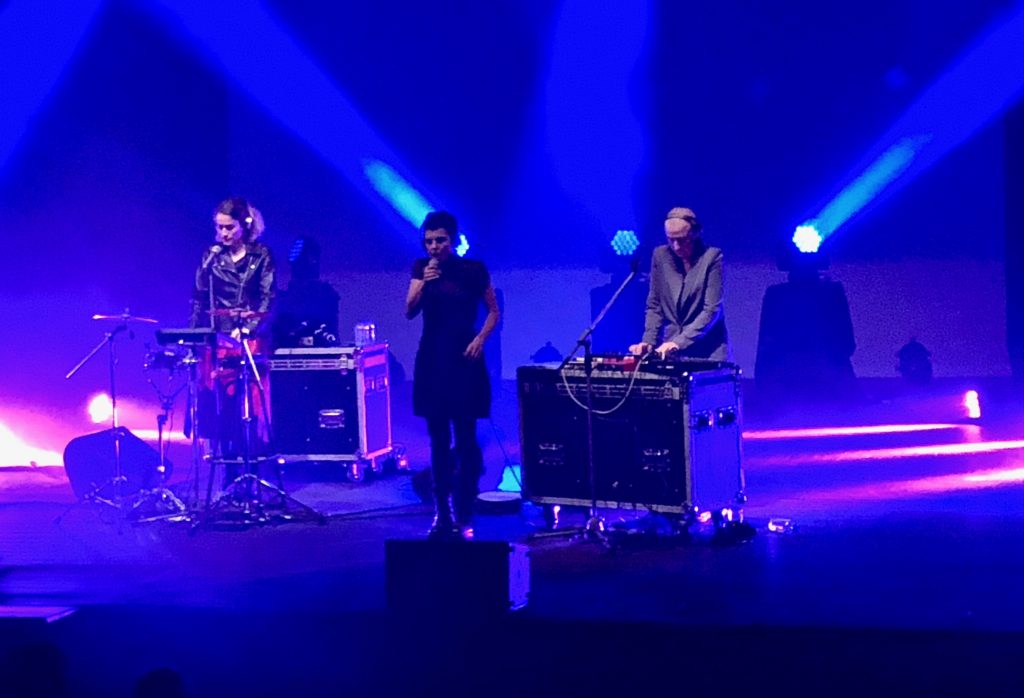
Curious to taste wine at a vineyard, see cork forests and some of the countryside, we set off one afternoon to find Fixete, an award winning winery suggested to us by the chef of Momentos, a restaurant we liked. Despite directions from the hotel and a GPS, we went way off course to an obscure winery with a similar address deep into the back county on a dirt road. Along the way, we saw no forests but noticed many areas with trees dispersed as if by design rather than growing wild. These turned out to be the cork “forests”, but the named forest we were directed to by the hotel turned out to be a cork factory.
After stopping at a small café in remarkably clean village we eventually found Fixete, an ultramodern building surrounded by vines, but the tasting fee of E20 for two tiny tastes was annoyingly prohibitive. The afternoon was not a total loss as we did find the local equivalent of Stonehenge on the way back to Evora. For a while, driving on yet another narrow dirt road, it felt like one more wild goose chase, but at the end there indeed was an oval of huge boulders, quite dramatic, dating to 5500 BCE, about 2000 years older than Stonehenge. On the walk back to the car, we noticed recently harvested cork trees with the bark chopped off, looking partly naked.
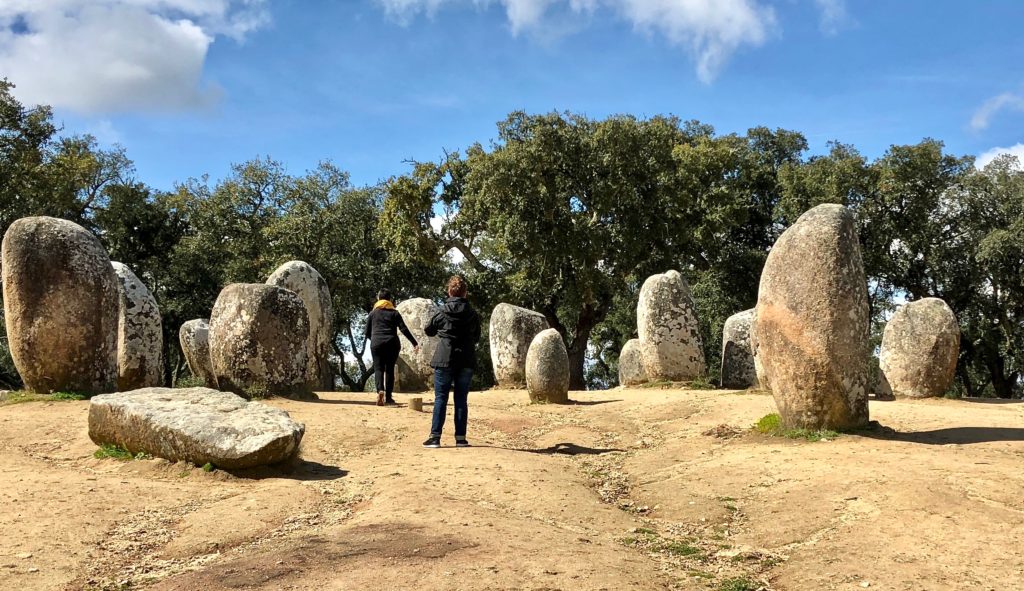
We ate and drank unusually well in Evora’s modern restaurants. We arrived in the early afternoon feeling hungry after long drive. Hotel staff directed us to Enoteca Cartuxa, an elegant restaurant on the other side of the Roman Temple. My friend had Duck escabeche with spices and almond farofa (fried cassava with almond flour) and I had a wafer slice of Cod with stick-thin fries and a poached egg mixed up at the table with an excellent, light and refreshing Alvarinho from their eponymous winery. We had an unexceptional traditional Portuguese dinner in the hotel’s charming dining room, situated in the cloisters around a patio-garden with orange trees. On subsequent evenings, we walked down to Momentos, a highly recommended restaurant, almost hidden in between the shops of the main street of the Old Town. The garrulous and idiosyncratic chef, helped by a cheerful young waiter, served small plates of gourmet food and good wine in a cozy room with about 6 tables. Dishes like: wild mushrooms cooked in olive oil with white truffles, accompanied by sautéed spinach and asparagus; prawns with strawberries, ginger and honey; eggplant fritters tempura with a chocolate and cinnamon dipping sauce; and meaty, but soft pieces of Monkfish on a bed of sautéed vegetables. The dishes were artistically served on rectangles of black slate with an array of spices strewn at the edges to give diners a choice to further enhance the taste.
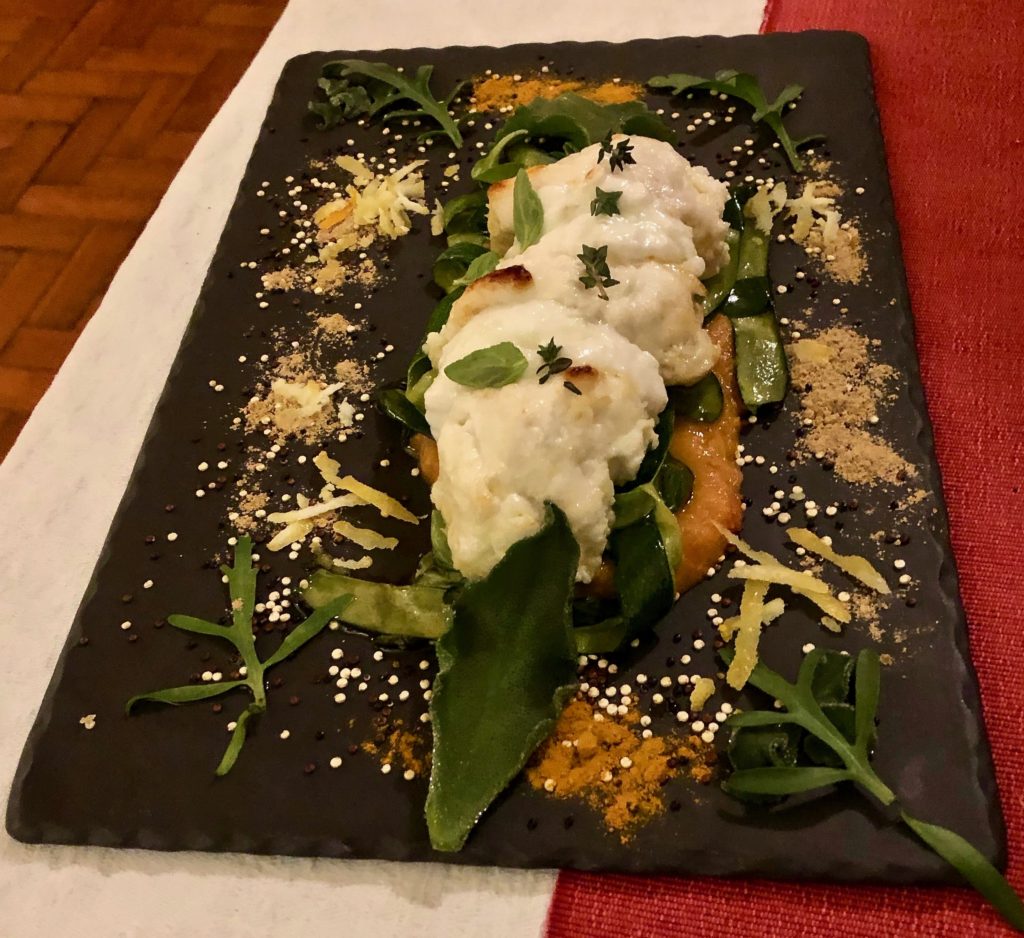
Hotels
Porto: Casa dos Loios by Shaidu was on a busy pedestrian-only street walking distance from all the main tourist sites. It was two old four-storey houses, one behind the other, connected by a wood floored deck on top of the second floor. Our rooms were in the back house on the third floor. The rooms were small, clean, modern cabins placed in a row with a passageway, like on a ship. Everything worked well and staff was very helpful with directions and advice.
Lisbon: Lx Boutique Hotel was centrally located and the old building was converted into modern rooms that were cabins as well, just a bit smaller than those in Porto, with no place to sit. The entry to the bathroom was like an elongated porthole with several inches of wood at the base that was a hazard going in and out in the dark. On my second stay, I got a large room in front of the building with a great view of the river and ocean, but street noise on Saturday night kept me up until 4 am. Staff was great and the free tasty Nata pastries and Port after 2 pm every day was something to look forward to.
Lagos: Hotel Marina Rio was a newish, modern hotel situated on the main street opposite the marina, a few minutes walk from the old town. It had good-sized comfortable rooms. As it was off-season, staff support was sparse, but helpful.
Evora: Convento dos Loios located within walking distance of all the historic sites and great modern restaurants. Its common areas—lounge, dining room, and reception—retained the 15th century monastic architecture, but the cells (rooms) were only somewhat modernized. My cell was tiny and hot enough in cool weather for me to turn on the air-conditioner for a few hours. The bathroom was dated and I could hear flushes from other rooms through the night. Food was mediocre but staff was courteous and very helpful.

